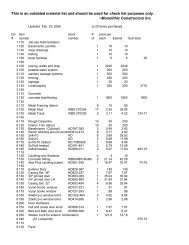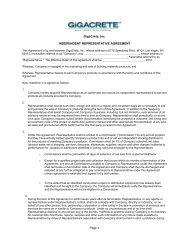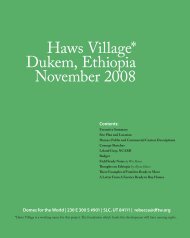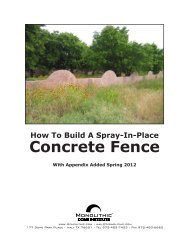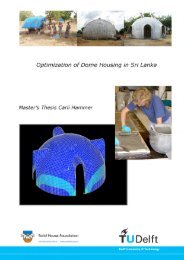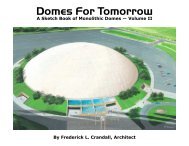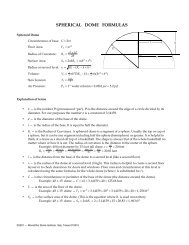Literature Review on Building Envelope, Heating and ... - Beeshive.org
Literature Review on Building Envelope, Heating and ... - Beeshive.org
Literature Review on Building Envelope, Heating and ... - Beeshive.org
You also want an ePaper? Increase the reach of your titles
YUMPU automatically turns print PDFs into web optimized ePapers that Google loves.
Triple-glazed windows (about RSI-0.9 (R-5)) with two low-e coatings, arg<strong>on</strong> gas fill, low<br />
c<strong>on</strong>ductivity spacer bars, <strong>and</strong> wood frames were used.<br />
The injected cellulose insulati<strong>on</strong> made the building envelope more airtight as compared to<br />
using fibreglass insulati<strong>on</strong>. Additi<strong>on</strong>al measures ensured good air tightness of the building<br />
envelope. All joints in the air/vapour barrier were carefully sealed with acoustical sealant; the<br />
rim joists were wrapped with Tyvek® that was sealed to the poly. The blower door test result<br />
for the house was 0.47 ach at 50 Pa. The Canadian R-2000 st<strong>and</strong>ard is 1.5 ach at 50 Pa.<br />
Indoor air quality features included the following.<br />
A balanced heat recovery ventilator (HRV) included a high-efficiency double-core plate airto-air<br />
heat exchanger. The HRV unit was run c<strong>on</strong>tinuously at 100 CFM (47 litres per sec<strong>on</strong>d)<br />
to ensure a high indoor air quality.<br />
Dry basement systems prevent mould <strong>and</strong> mildew growth. Installing exterior perimeter water<br />
drainage <strong>and</strong> proofing, <strong>and</strong> insulating the floor slab (RSI-6.2 (R-35)) accomplished this.<br />
Particleboard, OSB, wall-to-wall carpets, <strong>and</strong> vinyl flooring were avoided to avoid off<br />
gassing of volatile <strong>org</strong>anic compounds (VOC). Douglas fir plywood for the sub-floor,<br />
solid hemlock fir joists, <strong>and</strong> prefinished solid oak strip <strong>and</strong> ceramic tiles were used for<br />
flooring. Kitchen cabinets <strong>and</strong> vanities were birch plywood <strong>and</strong> solid oak. Low-VOC<br />
paints were used.<br />
Green features included the following.<br />
Scrap gypsum was added to the interior walls to cut down <strong>on</strong> l<strong>and</strong>fill waste <strong>and</strong> provide<br />
additi<strong>on</strong>al thermal mass, which helped moderate the temperature swing in the house caused<br />
by solar gain. In summer, the flywheel effect of the walls’ thermal mass kept the home cooler<br />
during the heat of the day <strong>and</strong> warmer during the night <strong>and</strong> early morning hours.<br />
No air c<strong>on</strong>diti<strong>on</strong>ing was needed, because of the fenestrati<strong>on</strong> design <strong>and</strong> overhangs <strong>on</strong> all<br />
the south windows that limit overheating during the summer period. Also, efficient<br />
appliances were used to reduce internal heat gains. Compact fluorescent <strong>and</strong> T8 lamps<br />
were used for lighting. Shiny reflectors were used over the kitchen light to enhance<br />
lighting quality.<br />
Decorative shutters <strong>on</strong> the smaller north-facing windows gave the appearance of larger<br />
windows without the heat loss <strong>and</strong> poor solar performance that accompanies large north<br />
windows during the coldest part of the winter.<br />
The house was oriented so windows faced south for passive solar gain. An active solar<br />
hot water system with 15.6 m 2 (168 sq. ft.) of selective-surface liquid solar panels had a<br />
low-cost wood-framed, EPDM -lined tank, which holds about 5300 litres (1400 US<br />
gall<strong>on</strong>s) of water. This large water tank improves the year-round efficiency of the solar<br />
collecti<strong>on</strong>. The hot water in the tank is used to heat the domestic hot water <strong>and</strong> also heats<br />
the house. This operates via a water-to-air heat exchanger within the forced air furnace,<br />
which uses a brushless direct current fan motor. The fan provides about 800 cfm (376<br />
PERD-079: Task 2 - <str<strong>on</strong>g>Literature</str<strong>on</strong>g> <str<strong>on</strong>g>Review</str<strong>on</strong>g> 63



